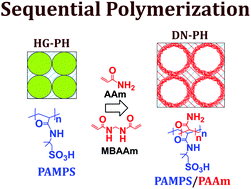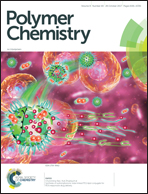Hydrogels through emulsion templating: sequential polymerization and double networks
Abstract
Double-network (DN) hydrogels are a combination of two very different polymer networks. Here, porous hydrogels with DN structures were successfully synthesized in two sequential free-radical polymerization steps. The first network was templated within a high internal phase emulsion (HIPE) to yield a hydrogel polyHIPE (HG-PH). The double network hydrogel polyHIPEs (DN-PHs) combined a more rigid highly crosslinked, polyelectrolyte (poly(2-acrylamido-2-methylpropanesulfonic acid), PAMPS) first network with a more ductile, crosslinked, neutral (polyacrylamide, PAAm) second network. The DN-PHs were generated from the as-synthesized HG-PHs by imbibing an aqueous AAm solution followed by polymerization. HG-PHs with 70% porosity absorbed significantly more of the AAm solution than HG-PHs with 85% porosity. The density of the DN-PHs increased with increasing AAm concentration, resulting in an increase in the modulus and toughness of both the swollen and the dry DN-PHs. The DN-PHs based on a HG-PH with 85% porosity did not release their water and did not fail up to compressive strains of 70%, recovering their shapes upon the removal of stress. A comparison with inverse DN-PHs, synthesized using the reverse sequence of polymerization, demonstrated that the properties were strongly dependent both on the composition and on the sequence.



 Please wait while we load your content...
Please wait while we load your content...